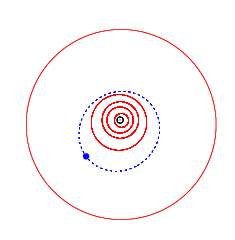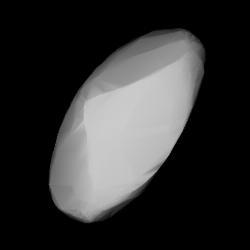Related Research Articles
1575 Winifred, provisional designation 1950 HH, is a stony Phocaea asteroid and slow rotator from the inner regions of the asteroid belt, approximately 9.5 kilometers in diameter.

9963 Sandage, provisional designation 1992 AN, is a stony Phocaea asteroid from the inner regions of the asteroid belt, approximately 6 kilometers in diameter.
4899 Candace, provisional designation 1988 JU, is a background asteroid from the inner regions of the asteroid belt, approximately 7 kilometers in diameter. It was discovered on 9 May 1988, by astronomer couple Carolyn and Eugene Shoemaker at the Palomar Observatory in California, United States. The asteroid was named after American chemist Candace Kohl.

2839 Annette is a bright Flora asteroid from the inner regions of the asteroid belt. It was discovered on 5 October 1929, by American astronomer Clyde Tombaugh at Lowell Observatory during his search for Pluto. The presumed S-type asteroid has a rotation period of 10.5 hours and measures approximately 5 kilometers in diameter. It was named after the discoverer's daughter.
11277 Ballard, provisional designation 1988 TW2, is a Phocaea asteroid from the inner regions of the asteroid belt, approximately 6.3 kilometers (3.9 miles) in diameter. It was discovered on 8 October 1988, by American astronomer couple Carolyn and Eugene Shoemaker at the Palomar Observatory in California. The assumed S-type asteroid has a rotation period of at least 10 hours. It was named for American marine scientist Robert Ballard.
6084 Bascom, provisional designation 1985 CT, is a binary Phocaea asteroid from the inner regions of the asteroid belt, approximately 6.3 kilometers in diameter. It was discovered on 12 February 1985, by American astronomer couple Carolyn and Eugene Shoemaker at Palomar Observatory in California. It is named after American geologist Florence Bascom. Its satellite measures approximately 2.3 kilometers and has an orbital period of 43.51 hours.
2033 Basilea, provisional designation 1973 CA, is a stony asteroid from the inner regions of the asteroid belt, approximately 6 kilometers in diameter. It was discovered on 6 February 1973, by astronomer Paul Wild at the Zimmerwald Observatory near Bern, Switzerland. The asteroid was named for the Swiss city of Basel.
29292 Conniewalker, provisional designation 1993 KZ1, is a bright, stony Phocaea asteroid and slow tumbler from the inner regions of the asteroid belt, approximately 4.6 kilometers in diameter. It was discovered on 24 May 1993, by American astronomer Carolyn Shoemaker and Canadian astronomer David Levy at the Palomar Observatory in California, United States.
4008 Corbin, provisional designation 1977 BY, is a stony Phocaea asteroid from the inner regions of the asteroid belt, approximately 6 kilometers in diameter. It was discovered on 22 January 1977, by staff members of the Felix Aguilar Observatory's at the Leoncito Astronomical Complex in Argentina.
4340 Dence, provisional designation 1986 JZ, is a background or Phocaea asteroid from the inner regions of the asteroid belt, approximately 8 kilometers in diameter. It was discovered on 4 May 1986, by American astronomer Carolyn Shoemaker at the Palomar Observatory in California. The S-type asteroid has a rotation period of 7.5 hours. It was named after Canadian geologist Michael R. Dence.
3936 Elst, provisional designation 2321 T-3, is a stony Vestian asteroid from the inner regions of the asteroid belt, approximately 5 kilometers in diameter. The asteroid was discovered on 16 October 1977, by Dutch astronomer couple Ingrid and Cornelis van Houten at Leiden, on photographic plates taken by Dutch–American astronomer Tom Gehrels at Palomar Observatory in California, United States. It was named after Belgian astronomer Eric W. Elst.
19763 Klimesh, provisional designation 2000 MC, is a stony Phocaea asteroid and slow rotator from the inner regions of the asteroid belt, approximately 7 kilometers in diameter. Discovered by NEAT at Haleakala Observatory in 2000, the asteroid was named for NEAT's software specialist Matthew Klimesh.
15350 Naganuma, provisional designation 1994 VB2, is a stony background asteroid from the inner regions of the asteroid belt, approximately 4.3 kilometers (2.7 miles) in diameter. It was discovered on 3 November 1994, by Japanese astronomers Yoshio Kushida and Osamu Muramatsu at the Yatsugatake South Base Observatory. The likely S-type asteroid has a rotation period of 2.5 hours. It was named for the town of Naganuma in northern Japan.
1405 Sibelius, provisional designation 1936 RE, is a stony Florian asteroid from the inner regions of the asteroid belt, approximately 8 kilometers in diameter. It was discovered on 12 September 1936, by Finnish astronomer Yrjö Väisälä at Turku Observatory in Southwest Finland. The asteroid was named after composer Jean Sibelius.
23712 Willpatrick, provisional designation 1998 AA, is a stony Phocaea asteroid from the inner regions of the asteroid belt, approximately 5 kilometers in diameter.
4760 Jia-xiang, provisional designation 1981 GN1, is a background asteroid from the inner regions of the asteroid belt, approximately 5 kilometers (3 miles) in diameter. It was discovered on 1 April 1981, by astronomers at Harvard University's Oak Ridge Observatory in Massachusetts, United States. The presumed stony S-type asteroid was named after Chinese astronomer Zhang Jiaxiang. It has a rotation period of 14.96 hours.
1530 Rantaseppä, provisional designation 1938 SG, is a stony Florian asteroid from the inner regions of the asteroid belt, approximately 5 kilometers in diameter. Discovered by Yrjö Väisälä at Turku Observatory in 1938, it was later named after Finnish astronomer Hilkka Rantaseppä-Helenius.
7204 Ondřejov, provisional designation 1995 GH, is a stony asteroid from the middle region of the asteroid belt, approximately 6 kilometers in diameter. It was discovered on 3 April 1995, by Czech astronomer Petr Pravec at Ondřejov Observatory near Prague, Czech Republic.
1573 Väisälä, provisional designation 1949 UA, is a stony Phocaea asteroid, slow rotator and suspected tumbler from the inner regions of the asteroid belt, approximately 9 kilometers in diameter. It was discovered on 27 October 1949, by Belgian astronomer Sylvain Arend at the Royal Observatory of Belgium in Uccle, Belgium. It was named for Finnish astronomer Yrjö Väisälä.
6181 Bobweber, provisional designation 1986 RW, is a stony asteroid from the inner regions of the asteroid belt, approximately 5 kilometers in diameter. It was discovered on 6 September 1986, by American astronomer Eleanor Helin at the U.S. Palomar Observatory in California, and named after astronomer Robert Weber.
References
- 1 2 3 4 "JPL Small-Body Database Browser: 6398 Timhunter (1991 CD1)" (2017-05-04 last obs.). Jet Propulsion Laboratory . Retrieved 4 July 2017.
- 1 2 3 Schmadel, Lutz D. (2007). "(6398) Timhunter". Dictionary of Minor Planet Names – (6398) Timhunter. Springer Berlin Heidelberg. p. 529. doi:10.1007/978-3-540-29925-7_5841. ISBN 978-3-540-00238-3.
- 1 2 3 4 5 6 "LCDB Data for (6398) Timhunter". Asteroid Lightcurve Database (LCDB). Retrieved 15 March 2017.
- 1 2 "Asteroid 6398 Timhunter – Nesvorny HCM Asteroid Families V3.0". Small Bodies Data Ferret. Retrieved 27 October 2019.
- 1 2 3 4 Nugent, C. R.; Mainzer, A.; Bauer, J.; Cutri, R. M.; Kramer, E. A.; Grav, T.; et al. (September 2016). "NEOWISE Reactivation Mission Year Two: Asteroid Diameters and Albedos". The Astronomical Journal. 152 (3): 12. arXiv: 1606.08923 . Bibcode:2016AJ....152...63N. doi: 10.3847/0004-6256/152/3/63 .
- 1 2 3 4 Mainzer, A.; Grav, T.; Masiero, J.; Hand, E.; Bauer, J.; Tholen, D.; et al. (November 2011). "NEOWISE Studies of Spectrophotometrically Classified Asteroids: Preliminary Results". The Astrophysical Journal. 741 (2): 25. arXiv: 1109.6407 . Bibcode:2011ApJ...741...90M. doi:10.1088/0004-637X/741/2/90. S2CID 35447010.
- 1 2 3 Masiero, Joseph R.; Mainzer, A. K.; Grav, T.; Bauer, J. M.; Cutri, R. M.; Dailey, J.; et al. (November 2011). "Main Belt Asteroids with WISE/NEOWISE. I. Preliminary Albedos and Diameters". The Astrophysical Journal. 741 (2): 20. arXiv: 1109.4096 . Bibcode:2011ApJ...741...68M. doi:10.1088/0004-637X/741/2/68. S2CID 118745497 . Retrieved 15 March 2017.
- 1 2 Behrend, Raoul. "Asteroids and comets rotation curves – (6398) Timhunter". Geneva Observatory . Retrieved 15 March 2017.
- ↑ Veres, Peter; Jedicke, Robert; Fitzsimmons, Alan; Denneau, Larry; Granvik, Mikael; Bolin, Bryce; et al. (November 2015). "Absolute magnitudes and slope parameters for 250,000 asteroids observed by Pan-STARRS PS1 - Preliminary results". Icarus. 261: 34–47. arXiv: 1506.00762 . Bibcode:2015Icar..261...34V. doi:10.1016/j.icarus.2015.08.007. S2CID 53493339 . Retrieved 15 March 2017.
- 1 2 "6398 Timhunter (1991 CD1)". Minor Planet Center. Retrieved 15 March 2017.
- ↑ "MPC/MPO/MPS Archive". Minor Planet Center. Retrieved 15 March 2017.